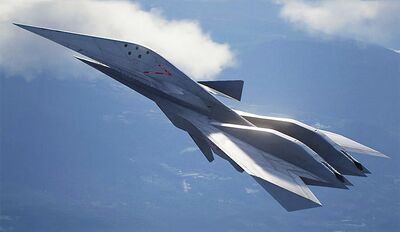Wyvern Dynamic Fighter
| WDF-A | |
|---|---|
 An airborne K-26A | |
| General information | |
| Type | Fighter |
| Status | Active |
| History | |
| Manufactured | 2018-Present |
| Introduction date | 2020 |
Background
With Cordium fueled engines becoming more practical following the development of solid steel-alloys derived from Deactivated Cordium, the prospect of developing aircraft and vehicles with the astounding performance of even early CFEs was attractive to Weapon Manufacturers across the world. This was especially true in Kalaron's Experimental Design Division, a cross-corporation Development Group meant to fast-track the creation of new innovations. Having been part of the creation of the first cordium fueled engines, they were on the forefront of adapting and improving these designs, including the creation of several unmanned prototypes (SP-132, L4NC-3, D12-K) that all demonstrated increasing agility, thrust and performance. Ultimately, the performance of these designs reached the limits possible with their relatively fragile first generation alloys. However, while flawed, these preliminary airframes did expose another substantial problem to be overcome.
The design of the L4NC-3 was radically different from a conventional-winged jet, optimized for agility with heavily swept wings and a radically new aerodynamic adjustment system that enabled extremely high-G maneuvers up to the limits of the airframe's constitution. However, conventional sitting positions for the cockpit would have reduced the allowed gee-forces by a massive amount. At other times, this would have been discarded by the incoming Kyrsian Government, however, the rise of the Iron Cross mixed with a terrifying new possibility: Cordium Bombs. Testing in the Greylock Saltflats revealed two facts to Kalaronian Scientists, Cordium was both explosive under the right conditions, and required relatively little to induce large explosive effects. Worse yet, taken alongside the advances in Engine Development, this opened new possibilities in the delivery of weaponry that a conventional air-defense system might not necessarily be able to deal with. Because of this, the absolute maximum in agility and resilience -both in Pilot and in aircraft- was needed. The decision was made, the next fighter in development would retain the technical L4NC-3 designation, becoming the L4NC-3α, and would receive an innovative full-body Augmented Reality Display System to deal with their new prone position.
Development=
Flush with funding following the increase of threats from the Iron Cross, the Wyvern was designed to fully achieve aerial dominance over a battlefield, utilizing new Second Generation Cordium Alloys in a number of applications, not the least of which included a central Railgun fed from an ammunition link to a canister in the air-frame. Two Cordium Engines were simulated to provide 250,000kN of thrust each, creating enough stress to require specialized nacelles to securely mount them to the aircraft itself, while also reinforcing the superstructure.
Design
Chiefly among the design concerns was the creation of a suitable agile aircraft to dominate the skies. This meant that the aircraft must have both heavily oversized engines and a deep internal magazine for missiles, such that it would be able
Operational history
Early service
Anti-bomber operations
Post-war service
Variants
The prototype flown in the 1939 fighter competition was designated Chikai WH 25, with WH indicating wŏnhyŏng (prototype). Six were built. Its armament consisted of four 7.5mm machine guns: two above the nose, and one in each wing. Each gun was fed from a 500-round belt.
Type 40-I
Type 40-II
Type 40-III
Type 40-IV
Type 40-V
Specifications (Type 40-I)
General Characteristics
- Crew: 1
- Length: 20 meters
- Wingspan: 14.1 meters
- Height: 5.5 meters
- Wing Area: 80.1 meters
- Empty Weight: 20,000 kg
- Loaded Weight: 41,000 kg
- Powerplant: 2X Cordium Fuel Engines, XE-231
Performance
- Maximum Speed: Mach 4
- Range: 4,000 nmi
- Service Ceiling: 22,000 Meters
- Rate of Climb:
- Wing Loading: 77.2 lb/sq ft (377 kg/m2)
- Power-to-Mass ratio: 4
Armament
- Guns:
- 1x GUNGIR 20mm Rotary Cannon
- Missiles:
- 8x Atrox Air-To-Air Dual-Seeker missiles
- 2x Sunstrike Air-To-Ground Missile
- 2x Thunderstrike Air-To-Sea Missile